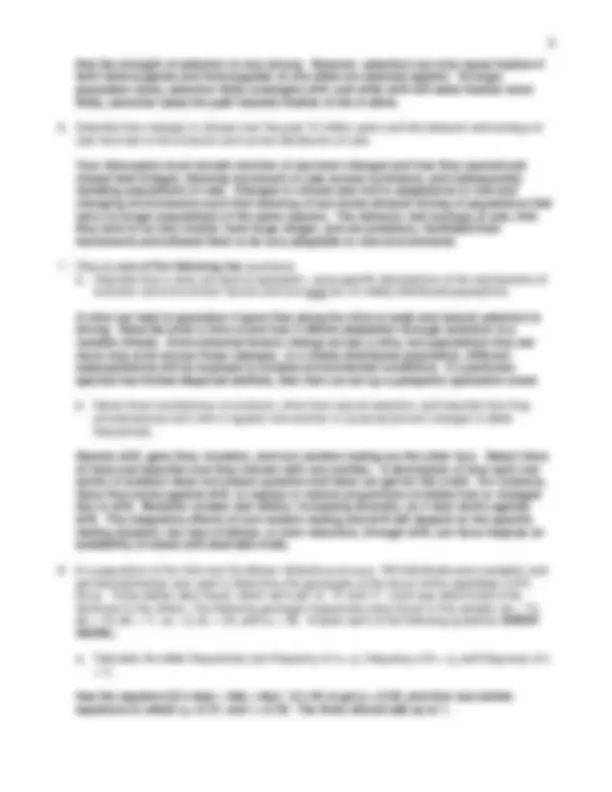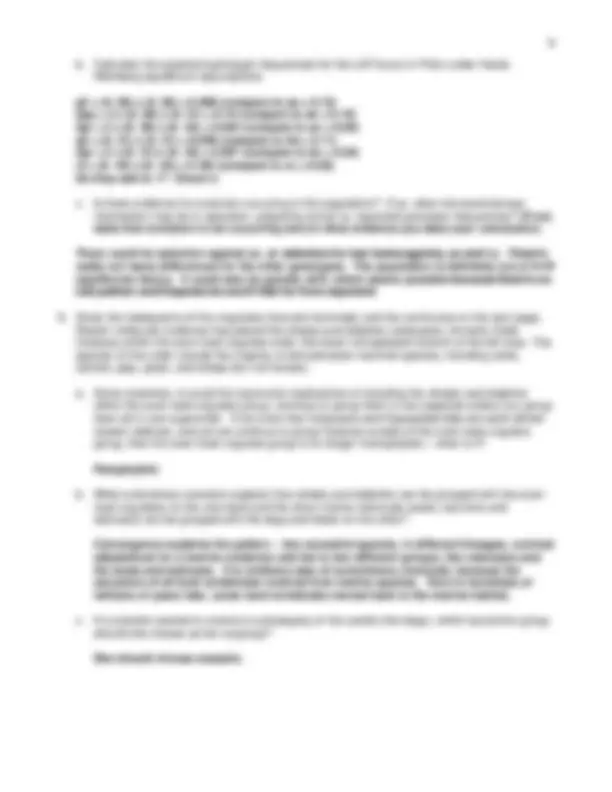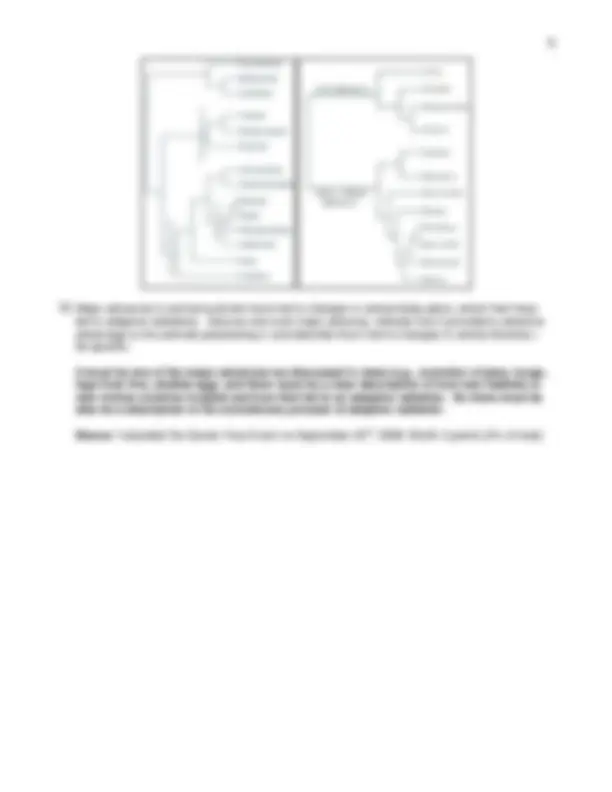





Study with the several resources on Docsity

Earn points by helping other students or get them with a premium plan


Prepare for your exams
Study with the several resources on Docsity

Earn points to download
Earn points by helping other students or get them with a premium plan
Community
Ask the community for help and clear up your study doubts
Discover the best universities in your country according to Docsity users
Free resources
Download our free guides on studying techniques, anxiety management strategies, and thesis advice from Docsity tutors
Material Type: Notes; Class: Organisms,Evolution,Ecosystems; Subject: Biology; University: Davidson College; Term: Fall 2008;
Typology: Study notes
1 / 5

This page cannot be seen from the preview
Don't miss anything!




BIO 112: Organisms, Evolution, and Ecosystems Review 1 Key Dr. Chris Paradise Fall 2008
You must discuss how Darwin’s theory included the idea of descent with modification (although you didn’t need to use that exact phrase; you could discuss the evidence of general shared traits that were widespread among descendents of a common ancestor) and that the mechanism of evolution is natural selection. Unity is observed in the shared traits among related species, while diversity is observed in the adaptations of individual species to their specific environments. You can use any group to describe these facets of evolution. For instance, all rodents share a couple of characteristic traits, such as incisors that continue to grow throughout their lifetimes, and yet, through speciation and an adaptive radiation, each species of rodent has adapted unique derived traits for the particular niche of that species. To earn full credit, you must have discussed the ideas that natural selection leads to adaptations to new or changing environments, isolation of gene pools leads to speciation and possibly adaptive radiations and also leads to some mode of speciation, such as allopatry.
There were two ways that this question was answered; either as an experiment to test for adaptation to an environmental condition or as an experiment to test for phenotypic plasticity. The research and null hypotheses developed must be testable, and the experiment described must test the hypotheses adequately to receive full credit. An experiment that is well designed but does not test the hypothesis will not receive full credit. For instance, if the hypothesis mentions evolution over time and only one generation is examined in the experiment, then the design of the experiment is considered to be flawed, as there is very little evolution that can occur in one generation (unless polyploidy is explicitly stated); this design is more appropriate to examine phenotypic plasticity.
The MSC is applicable to a wide range of species, although it falls short when used for species that cannot be easily distinguished based on appearance, such as bacteria and other microbes. It is also not applicable to polymorphic or sexually dimorphic species. It is easy to use, often requiring only examination of morphology. The BSC is applicable only to species that reproduce sexually and it is not very easy to use, requiring a demonstration that individuals can actually mate and produce fertile offspring.
Adults live only for a couple of months in the summer, mate, lay eggs, and die. Each female is capable of laying dozens to hundreds of eggs. Answer all of the following questions (15 pts). a. What kind of reproductive isolation exists between broods?
Temporal isolation, because each brood emerges in a different year. I accepted geographic only if a good case was made as to how that could lead to isolation.
b. LIST the mechanism(s) of evolution that is (are) likely to be acting on this species.
The mechanisms that could be involved include natural selection, genetic drift, and mutation. Gene flow is not likely, and there’s really no reason, from the information given to suspect non-random mating.
c. If cicadas underwent speciation in this scenario, what kind of speciation would it be, and why?
Sympatric, if temporal isolation, and allopatric if geographically isolated.
d. What would you predict might be a consequence to between-brood variation and within-brood variation for broods isolated in such a manner?
Between-brood variation would increase, and within-brood variation would decrease.
a. What two mechanisms of evolution are most likely acting on these populations?
Genetic drift and natural selection are both occurring, in both graphs.
b. Describe the two graphs and compare/contrast the relative strengths of the two mechanisms named in part “a”.
Fixation of the “A” allele occurs in both graphs, and from the trajectory of change, it appears that selection is acting, at least to some degree. The population size is different in each graph, which you can detect in the time it takes for fixation to occur and the magnitude of changes that that occur from generation to generation. Because fixation occurs so quickly in the bottom graph, it is likely that the population size is very small or
b. Calculate the expected genotypic frequencies for the LAP locus in Phlox under Hardy- Weinberg equilibrium assumptions.
p2 = (0. 26) x (0. 26) = 0.068 (compare to aa = 0.15) 2pq = 2 x (0. 26) x (0. 31) = 0.16 (compare to ab = 0.16) 2pr = 2 x (0. 26) x (0. 43) = 0.224 (compare to ac = 0.06) q2 = (0. 31) x (0. 31) = 0.096 (compare to bb = 0.11) 2qr = 2 x (0. 31) x (0. 43) = 0.267 (compare to bc = 0.24) r2 = (0. 43) x (0. 43) = 0.185 (compare to cc = 0.28) Do they add to 1? Check it.
c. Is there evidence for evolution occurring in this population? If so, what microevolutionary mechanism may be in operation, judged by actual vs. expected genotypic frequencies? (If not, state that evolution is not occurring and on what evidence you base your conclusion)
There could be selection against ac, or selection for two homozygotes, aa and cc. There’s really not many differences for the other genotypes. The population is definitely out of H-W equilibrium theory. It could also be genetic drift, which seems possible because there’s no real pattern and frequencies aren’t that far from expected.
a. Some scientists, to avoid the taxonomic implications of including the whales and dolphins within the even-toed ungulate group, continue to group them in two separate orders, but group them all in one superorder. If we know that Cetaceans and Hippopotamidae are each others’ closest relatives, and yet we continue to group Cetacea outside of the even-toed ungulate group, then the even-toed ungulate group is no longer monophyletic – what is it?
Paraphyletic
b. What evolutionary scenario explains how whales and dolphins can be grouped with the even- toed ungulates on the one hand and the other marine mammals (seals, sea lions and walruses) can be grouped with the dogs and bears on the other?
Convergence explains the pattern – two ancestral species, in different lineages, evolved adaptations for a marine existence and led to two different groups, the cetaceans and the seals and walruses. It is evidence also of evolutionary reversals, because the ancestors of all land vertebrates evolved from marine species. Tens to hundreds of millions of years later, some land vertebrates moved back to the marine habitat.
c. If a scientist wanted to construct a phylogeny of the canids (the dogs), which taxonomic group should she choose as her outgroup?
She should choose weasels.
led to adaptive radiations. Discuss one such major advance, indicate how it provided a selective advantage to the animals possessing it, and describe how it led to changes in animal diversity – be specific.
It must be one of the major advances we discussed in class (e.g., evolution of jaws, lungs, legs from fins, shelled egg), and there must be a clear description of how new habitats or new niches could be invaded and how that led to an adaptive radiation. So there must be also be a description of the evolutionary process of adaptive radiation.
Bonus: I attended the Darwin Year Event on September 23rd, 2008: Worth 3 points (2% of total).